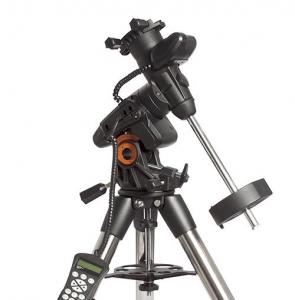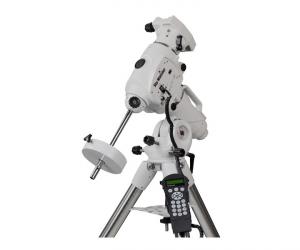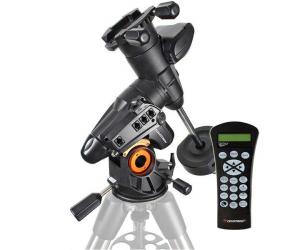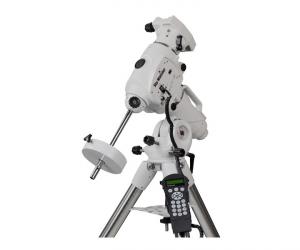- Telescopes
- Overview:
Telescopes - Achromatic Refractor
- Apochromatic Refractor
- Overview:
Apochromatic Refractor - ED Refractor - less color aberration than an achromatic
- SD APO - color free 2-element APO objective
- EDT APO - 3 element ED objective
- High End APO with 3-element APO objective - no color aberation
- Flatfield APO with flat field for Astrophotography
- All Apos and EDs from all manufacturers - large overview
- TS APO and ED from Japan with high quality optics
- Overview:
- Newtonian Telescopes
- Dobsonian Telescopes
- RC Ritchey Chretien Telescopes
- Casssegrain Telescopes
- Reflektor Telescopce with Lens Correcture
- Maksutov Cassegrain Telescopes
- GoTo Telescopes
- Solar Telescopes H-Alpha
- Overview:
- Mounts Tripods Rings Rails Power Supply ...
- Overview:
Mounts Tripods Rings Rails Power Supply ... - Mounts Equatorial with GoTo
- Mounts Equatorial without GoTo
- Mounts Azimutal with GoTo
- Mounts Azimutal without GoTo
- Mounts GoTo - Harmonic Drive
- Travel mounts for astro imaging
- Tripods Piers Polar Wedges
- Mount Control & Electronics
- Dovetail Clamps, Plates and Mount Adapters
- Tube Rings
- Power Supply
- Counterweights Balance Weights
- Mount Accessories - Other
- Overview:
- Telescope Accessories
- Overview:
Telescope Accessories - Eyepieces
- Barlows & Reducer Lenses
- Diagonal Mirrors and Prisms
- Binocular Viewers
- Finder Scopes
- Telescope Collimation and Test
- Cleaning Tools
- Transport and Storage
- Dust protection for Telescopes & Accessories
- Stray Light Protection
- Dewcaps and Heater
- Focusers, Adapters, Motorfocus
- Telescope DIY & Improvement
- Other telescope accessories
- Replacement Parts
- Overview:
- Filters
- Overview:
Filters - Color Filters and Color Filtersets
- Nebular Filters for Visual Observing
- Neutral-Density and Polfilter
- Photo Narrowband Nebular Filters
- Photo Broadband Filters
- Photo Planetary Filters
- Photo R-G-B and IR Cut Filters
- Photo - Filtersets
- Photometric Filters
- Clip Filter for DSLR Cameras
- Filter Wheels and Filterslider
- Solar Filters for white light
- Solarfilter for H-Alpha and Calcium
- Overview:
- Adaptors
- Overview:
Adaptors - Adapter 1,25" and 24,5mm
- Adapter 2"
- Adapter T2 - M42x0.75
- Adapter M48x0,75
- Adapter M54
- Adapter SC
- Adapter M63
- Adapter M68
- Adapter to other Threads
- Adapter Extensions
- Adapter camera bayonet
- Adapter Objective Filterthread
- Adapter Quick Changing , Rotation
- Adapter Eyepiece Projection
- Adapters Tilting
- Overview:
- Astrophotography and Photography
- Overview:
Astrophotography and Photography - Cooled Cameras
- Cameras without Cooling
- Deep-Sky Cameras uncooled
- Set-Offers Camera, Filter, Wheels
- Acessories for Cameras
- Travel mounts for astro imaging
- Imaging Correctors for Telescopes
- Autoguiding Cameras & Sets
- Everything for Guiding
- Focusing aids - Bahtinov mascs
- Flat Field foils and boxes
- Lenses for Cameras
- Piggyback Camera Holder
- Camera Bags, Photocases & more
- Digital Camera and Smartphone Adapter
- Other photo accessories
- Overview:
- Binoculars, Spotting Scopes, Microscopes, Range Finders
- Overview:
Binoculars, Spotting Scopes, Microscopes, Range Finders - Spotting Scopes and Acessories
- Roof Prism Binoculars
- Binoculars with Porro prisms
- Binoculars from 100mm Aperture
- Binoculars with 1,25 inch eyepieces
- TSMX APO Binoculars
- Binoculars for Astronomy
- Binoculars Hiking Bird watching
- Monoculars - Opera Binoculars
- Accessories for Binoculars
- Range Finders
- Microscopy
- Bags for Phototripods & Binoculars
- Overview:
- Phototripods and Binomounts
- Books, Software
- Overview:
Books, Software - Books for Astronomy Beginners
- Star Charts and Planispheres
- Books about our Solar System
- Observing Tips for Amateurs
- Popular Astronomy Literature
- Teaching material
- Astrophotography books
- Telescopes, Observatories, Construction
- Calendars Yearbooks
- Software, Star Charts
- Books for Microscopers
- Books Nature and Animals
- Nature Photography TimeLapse
- Overview:
- Night Vision, Magnifiers, Weather, Domes & more
- Beginner Astronomy and Gift Ideas
- Second Hand & Special Offers
- New products
Manufacturer: -TS Montierungen
Product number: LS-M12
EUR59.00new
EUR 59,00
incl. 19 % VAT (DE)
The VAT indicated refers to that applicable in Germany. After logging in, the VAT amount is adjusted to the applicable VAT of the stored delivery country. Therefore, the final price may vary accordingly.
excl. 6.95 € shipping costs (DE)
more details to the shipping costs ...Please log in to calculate shipping costs to your country.
There are no reviews for this product
- Details..
- Technical data..
- In the box..
- Manufacturer infos..
- Safety informations..
TS Latitude screws for equatorial mounts, stainless steel
Most equatorial mounts for telescopes come equipped with a pair of bolts for latitude adjustment. While those screws work just fine in most cases, there are situations were you might want to exchange your screws, particularly the longer of the two screws:Nienna´s latitude screws address all of these problems.
Design
Each screw consists of the screw itself, a large handle, and a spring mechanism to engage or disengage the handle for free rotation.
The screw and the spring mechanism are made of high quality stainless steel of much higher strength than the mild steel screws commonly used in many mounts.
For the handle fibre-glass reinforced plastic was chosen. The reason for this choice is improved handling comfort at low temperatures.
The handle is pulled into a toothed ring which locks it in place. By pulling out the handle (or by pushing the tap in the middle with your thumb) the toothed ring is disengaged and allows you to rotate the handle freely without turning the screw itself.
Finding the correct thread size
Most equatorial mounts use metric threads for their latitude screws. The most common sizes are M8, M10, and M12, with the corresponding diameters of 8 mm, 10 mm, and 12 mm respectively.
There are a few mounts out there which use screws in imperial rather than metric, but those are increasingly rare and we do not currently offer replacement screws in these sizes.
The following is a list of known threads for the most common mounts. You will find that some mounts are listed with more than one thread. This happens when a mount has had a design change through its generations in which the thread was changed.
Please be sure to check your particular mount before ordering! For a handy trick on how to measure the diameter of your existing screws without a caliper check out our product manual!
Sky-Watcher
Celestron
Meade
Finding the best thread length
At lower latitudes the exact thread length does not matter. The worst that can happen is that the screw might stick out a bit further.
At higher latitudes however the length becomes important in two ways:
Therefore it is best practice to select the shortest screw that you can get away with whilst still reaching the "nose" in the latitude mechanism at your latitude, with a small amount of wiggle room.
You can try this out with your existing screw. Set your latitude on the mount, then measure how much of the threaded length of the screw is still visible. Remove the screw and measure its total threaded length, i.e. the length of the screw minus the length of its head and handle. Finally, subtract the length of the thread sticking out that you measured just a moment ago.
Example:
Let us say your latitude screw sticks out 12 mm once you have set the mount to your correct latitude. You can directly measure this with a ruler.
Once you have removed the screw from the mount you measure its threaded length to be 94 mm.
If we subtract 12 mm from 94 mm we get an ideal length of 82 mm. Let?s add a couple of millimetres just to be on the safe side and call it 84 mm instead.
The ideal replacement screw in this case should therefore be as close as possible to, but not shorter than 84 mm. Note: as mentioned above the screw will not usually get in the way at lower latitudes. If you have easy access to the polar scope and there is enough space between the mount and the screw to allow it to be adjusted, there is no need to select a shorter screw than the original.
About the scope of delivery
Each screw comes pre-assembled. A kit consists of exactly one screw. This is because typically only the longer of the two screws on most mounts might need replacement.
Manual
The supplier provides a user manual: Latitude_Screw_Manual.pdf
| Thread: | M12 |
| Thread length: | 94 mm |
| Material: | Stainless steel (screw, spring mechanism), GRP (handle) |
| Manufacturer / Importeur: | Teleskop-Service Ransburg GmbH |
| Street: | Von-Myra-Str. 8 |
| ZIP / City: | 85599 Parsdorf |
| Country: | Germany |
| Telefon number: | +49 89 99228750 |
| Email: | info@teleskop-service.de |
| Website: | www.teleskop-express.de |
Safety informations: PDF Download
Recommended accessories
Customers who bought this product also bought...
Celestron AVX GoTo Mount for Astronomy and Astrophotography
EUR 1.249,00RRP EUR 1.495,00you save 16.5% (EUR 246,00)
Celestron AVX GoTo Mount for Astronomy and Astrophotography - Mount head
EUR 999,00RRP EUR 1.495,00you save 33.2% (EUR 496,00)
Similar Products
Reviews























